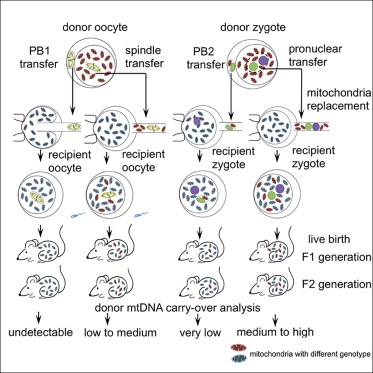新技术有望阻断线粒体遗传病
来源:《细胞》
作者:沙红英等
时间:2014-07-11

复旦大学今天宣布,该校医学神经生物学国家重点实验室沙红英、朱剑虹课题组,联合安徽医科大学曹云霞教授团队等,在探索遗传性线粒体疾病治疗研究方面取得突破性进展。相关研究论文日前发表于《细胞》。
据专家介绍,线粒体是为细胞提供能量的细胞器,它具有自身的一套DNA(mtDNA),通过母亲的卵子传递给下一代。发生在卵子中的线粒体突变可能引起母系家族性疾病。这种突变会导致严重的问题,受影响的大多数是能量需求高的器官,例如大脑、肌肉、心脏,涉及到一系列广泛的母源性遗传病,目前的治疗方案极为有限,患者只能靠药物短期缓解症状,无法治愈。此外,由于线粒体DNA是通过卵胞质以母源性遗传的方式进入下一代,故通常具有一定量线粒体DNA突变的携带者医生不建议生育。因此,该病给家庭带来痛苦和不幸。
极体是卵子在减数分裂过程中排出卵包膜外的“小细胞”。沙红英等研究人员以极体的生物学特性为理论基础和出发点,用极体中的遗传物质代替胞浆内的遗传物质,在两种不同线粒体遗传背景的小鼠之间进行线粒体置换研究。研究结果显示第一极体置换产生的子一代小鼠及其衍生的子二代小鼠体内仅含卵胞浆供体小鼠的线粒体,在最大程度上避免了异质线粒体DNA。同时,研究人员在小鼠上将极体移植、原核移植、纺锤体复合物移植在同一尺度进行比较,证明了极体的优越性及潜在的临床应用价值,有望能主动和彻底地预防线粒体母源性遗传疾病的发生。
沙红英表示:“尽管在动物模型上已经取得令人振奋的结果,但仍须进一步研究极体基因组置换技术在人类卵子/胚胎上的结局,并将这种置换的人胚胎与正常IVF胚胎进行详细的、长期的比较,从而为临床试验提供合适的证据。”(来源:中国科学报 黄辛)
Polar Body Genome Transfer for Preventing the Transmission of
Inherited Mitochondrial Diseases
Summary Inherited mtDNA diseases transmit maternally and cause severe phenotypes. Currently, there is no effective therapy or genetic screens for these diseases; however, nuclear genome transfer between patients’ and healthy eggs to replace mutant mtDNAs holds promises. Considering that a polar body contains few mitochondria and shares the same genomic material as an oocyte, we perform polar body transfer to prevent the transmission of mtDNA variants. We compare the effects of different types of germline genome transfer, including spindle-chromosome transfer, pronuclear transfer, and first and second polar body transfer, in mice. Reconstructed embryos support normal fertilization and produce live offspring. Importantly, genetic analysis confirms that the F1 generation from polar body transfer possesses minimal donor mtDNA carryover compared to the F1 generation from other procedures. Moreover, the mtDNA genotype remains stable in F2 progeny after polar body transfer. Our preclinical model demonstrates polar body transfer has great potential to prevent inherited mtDNA diseases.
原文链接:http://www.sciencedirect.com/science/article/pii/S0092867414006618




